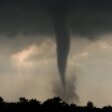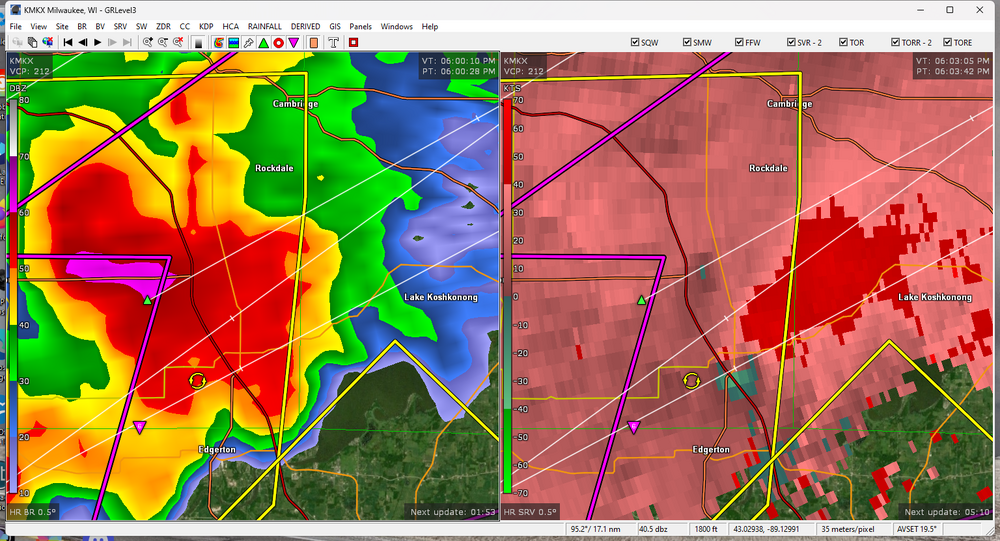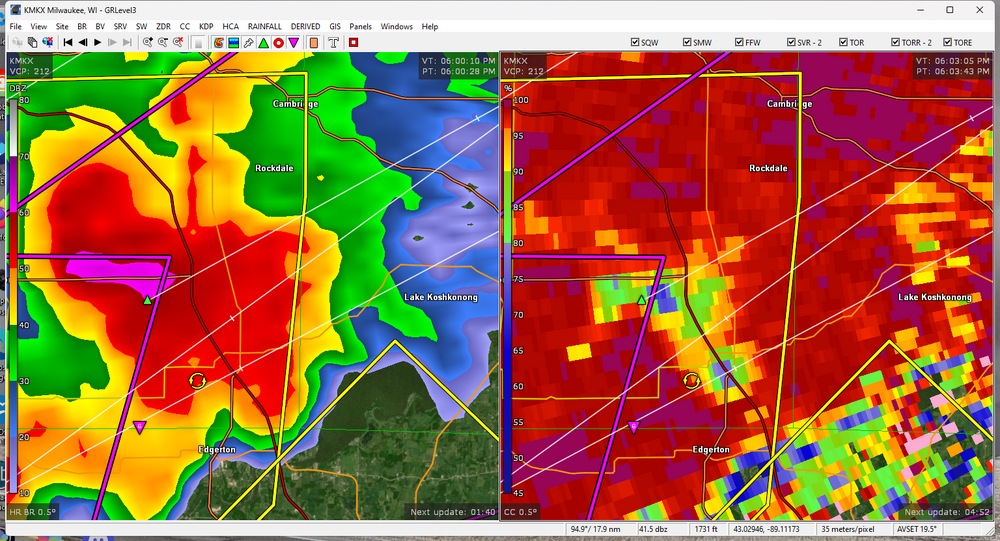-
Posts
3,305 -
Joined
-
Last visited
Content Type
Profiles
Blogs
Forums
American Weather
Media Demo
Store
Gallery
Everything posted by CheeselandSkies
-
@andyhb with a nice succinct breakdown of why the models are having such a hard time getting a handle on this setup over in Central/Western.
-
Zero mention from MKX in the AFD or HWO despite SPC Day 6 risk going right up to the state line and plenty of model runs nudging the warm sector into the southern tier or two of counties at least. Meanwhile the mets at my work have already gone with a "First Alert Day" for Tuesday.
-
Just a few small, dirty piles/patches left on north-facing/shady embankments/hills or in parking lots where the plows stacked up the two January storms that comprised the bulk of our "winter." Reviewing my railfan pictures/video, that's quite a difference from five years ago today: Ironically, most of that cover likely was the result of the "clipper train" discussed in this thread:
-
Touched 60 in Madison today. Still some snow piles along north-facing hills/embankments. @madwx
-

Winter 2023/24 Medium/Long Range Discussion
CheeselandSkies replied to Chicago Storm's topic in Lakes/Ohio Valley
Not great to see but I will add the caveat that models, particularly the GFS, are prone to being excessively progressive at this range. If we do end up with a nice large wavelength trough, it shouldn't move that fast. -

Winter 2023/24 Medium/Long Range Discussion
CheeselandSkies replied to Chicago Storm's topic in Lakes/Ohio Valley
Yup. Also had the outbreak featuring the Marseilles, Washburn & Crossville EF3s and the Perryville, MO-Christopher, IL EF4. This on the heels of one of the more notable icing events in southern Wisconsin in recent memory (for me at least). We actually had enough accretion to noticeably weigh down the trees, and leave a clear glaze on everything even after the sun came out the next day. 2016 also had a relatively early season outbreak in the region; March 15th seemed about the earliest possible non-ridiculous time of year (remembering events such as 3/13/90 and 3/12/06) for this area to me so I went out and chased, got a glimpse of the Trivoli-Hanna City EF2. Of course, when the next year rolled around, late February just seemed way too **** early so I sat that one out. Apparently the lesson didn't stick because I also sat out the Winterset day in 2022 because I thought March 5th was too early, although in my defense that setup also looked rather marginal on most of the model runs in the days leading up to it. By the time it began to look genuinely good closer to go time, I had already talked myself out of chasing. Keota day last year was also quite early season for the region, but with it being a moderate/eventually high risk and the models consistently showing that (lack of) deep moisture return would not be an issue, confidence was much higher. Now of course in 2024 we get something truly stupid, with tornadoes in Wisconsin on February 8th, with dewpoints not even reaching 50, and one of those being one of the longest-tracked and most impactful in the south-central part of the state in nearly ten years (going back to the cluster of late-night strong tornadoes on June 16-17, 2014, when an EF2 missed my apartment building by about two blocks while I was staying in a hotel, having driven to eastern Nebraska to whiff on what turned out to be the Pilger event). Ironically, the least likely six-week period out of the year to get tornadoes in the Midwest in recent years seems to have become what should be the peak; May through mid-June. -

2024 Short/Medium Range Severe Weather Discussion
CheeselandSkies replied to Chicago Storm's topic in Lakes/Ohio Valley
There was another angle showing a pretty clear debris circulation with the one near Albany. Obviously the emphasis is on Evansville etc. today but I think there were likely at least two tornadoes with this storm. Edit: Juda/Albany supposedly already confirmed EF1 but I have yet to see anything on MKX's event page, a PNS or their Facebook page. May be yet another instance of someone on X stalking the DAT. -

2024 Short/Medium Range Severe Weather Discussion
CheeselandSkies replied to Chicago Storm's topic in Lakes/Ohio Valley
That's news to me. I always thought they were rated on the single most destructive thing they did. -

2024 Short/Medium Range Severe Weather Discussion
CheeselandSkies replied to Chicago Storm's topic in Lakes/Ohio Valley
Seen a couple videos of the Evansville-Edgerton tornado. Actually looked smaller than I was expecting based on the size/depth of the CC drop. Must have been small but fairly strong, and hit a lot of stuff. -

2024 Short/Medium Range Severe Weather Discussion
CheeselandSkies replied to Chicago Storm's topic in Lakes/Ohio Valley
Can see the debris fallout on this scan. Go figure, this 2% day with dewpoints barely (if even) touching 50 will not only go down as the first February in Wisconsin history, but one most destructive/noteworthy in south-central Wisconsin in quite some time. Missed my parents just to the southeast, similar to the Dane Co. one from 3/31/23 which I called them about as I was on my way home from my Keota chase. -

2024 Short/Medium Range Severe Weather Discussion
CheeselandSkies replied to Chicago Storm's topic in Lakes/Ohio Valley
I think they did well. This is overachieving my expectations by a lot, otherwise I would have actually gone out lol. -

2024 Short/Medium Range Severe Weather Discussion
CheeselandSkies replied to Chicago Storm's topic in Lakes/Ohio Valley
Man. -

2024 Short/Medium Range Severe Weather Discussion
CheeselandSkies replied to Chicago Storm's topic in Lakes/Ohio Valley
Famous last words, lol. -

2024 Short/Medium Range Severe Weather Discussion
CheeselandSkies replied to Chicago Storm's topic in Lakes/Ohio Valley
Not too surprising unfortunately, although SPC has an MD out. https://www.spc.noaa.gov/products/md/md0113.html Shame, really because this is a nice setup otherwise. -

Winter '23-'24 Piss and Moan/Banter Thread
CheeselandSkies replied to IWXwx's topic in Lakes/Ohio Valley
GHD I was fun; although (at least in Milwaukee, where I was living at the time) the wind caused so much drifting that the snow depth elsewhere didn't really seem all that impressive to me. I have no memory at all of GHD II, as I don't think it affected southern Wisconsin all that much in terms of noteworthy totals. -

Winter 2023/24 Medium/Long Range Discussion
CheeselandSkies replied to Chicago Storm's topic in Lakes/Ohio Valley
SSWE is still a dirty word to me because I blame it for about 10 straight weeks of freezing my b***s off going to to my car at 2:50 AM for work; and then murdering the season between the April 27-28 Dixie event and the June 16-18 Pilger etc. outbreak in 2014; with BA temps constantly getting pumped into the Midwest all through May from the endless Hudson Bay vortex. I don't understand the nostalgia for that year on this forum. I've since learned it's more nuanced than that, but it still gives me PTSD. -
RRFS actually holding serve on subsequent runs. Marginal risk introduced.
-
We ready to kick off the 2024 severe weather discussion thread on February 6th? Although, there have been tornadoes in northern IL in early January (2008), and in mid-December in northern Wisconsin (2021), so anything is possible.
-
Just saw that on TalkWeather. Although it's actually for the timeframe valid for Thursday evening (and unfortunately, after dark this time of year).
-

Winter '23-'24 Piss and Moan/Banter Thread
CheeselandSkies replied to IWXwx's topic in Lakes/Ohio Valley
See you twice next season. Should be good games. Otherwise, 4 wins apiece against the Bears/Vikings sounds like a plan. -

Winter 2023/24 Medium/Long Range Discussion
CheeselandSkies replied to Chicago Storm's topic in Lakes/Ohio Valley
You'd think with all these AA temps we could at least get a winter outbreak, but nope. Trough coming through Saturday on the GFS is negatively tilted to the point of absurdity, with southeasterly flow at 500mb, and despite low 50s dewpoints all the way up to southeastern Nebraska, 60s remain offshore the Gulf coast! -

Winter 2023/24 Medium/Long Range Discussion
CheeselandSkies replied to Chicago Storm's topic in Lakes/Ohio Valley
Don't like that. Don't want to see more fires/smoke. -

Winter 2023/24 Medium/Long Range Discussion
CheeselandSkies replied to Chicago Storm's topic in Lakes/Ohio Valley
-

January 22-23 Potential Ice Event
CheeselandSkies replied to HillsdaleMIWeather's topic in Lakes/Ohio Valley
From yesterday's afternoon AFD, MKX didn't seem to concerned about ZR in our neck of the woods. Just wet snow turning to rain. -
Yeah, not looking forward to the drive to and from work Tuesday (my weekend is currently Sunday-Monday); even though coming home Friday and going in Saturday morning weren't as bad as I'd feared.








